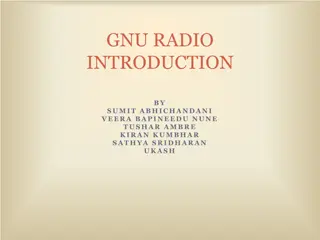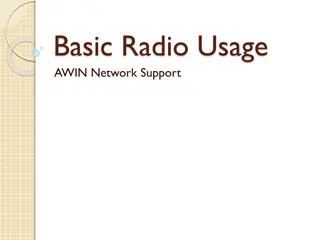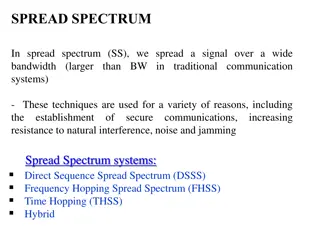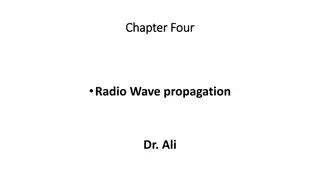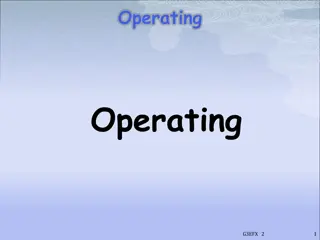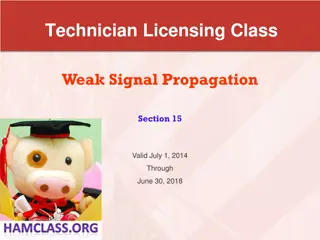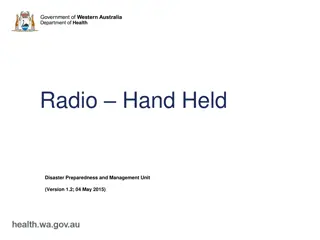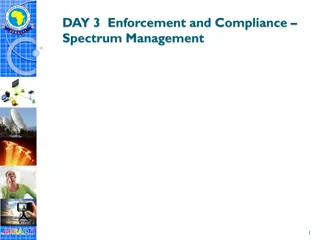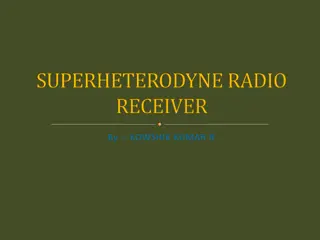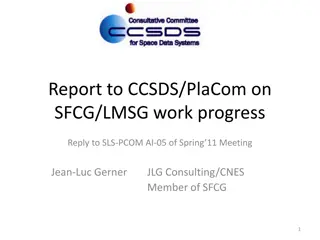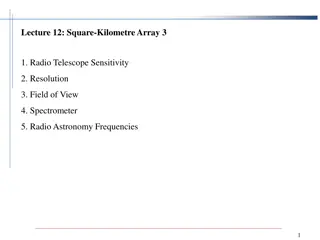Importance of Spectrum Management for Radio Frequency Assignments
Spectrum management is crucial due to the increasing global demand for radio communications. Effective coordination and notification processes help ensure equitable access to radio frequencies and prevent interference, as highlighted by the Master International Frequency Register and the significance of proper notification procedures. Electronic notification formats are essential for handling a variety of notice types efficiently, as detailed in Resolution 906 (WRC07).
Download Presentation

Please find below an Image/Link to download the presentation.
The content on the website is provided AS IS for your information and personal use only. It may not be sold, licensed, or shared on other websites without obtaining consent from the author.If you encounter any issues during the download, it is possible that the publisher has removed the file from their server.
You are allowed to download the files provided on this website for personal or commercial use, subject to the condition that they are used lawfully. All files are the property of their respective owners.
The content on the website is provided AS IS for your information and personal use only. It may not be sold, licensed, or shared on other websites without obtaining consent from the author.
E N D
Presentation Transcript
Notification of frequency Assignments for recording in the Master Register Prepared by : Eng.yasir Mohammed Bashar Yasir_192@ntc.gov.sd 2
Spectrum management The ever-increasing global application of different means of radiocommunications and a need for correct management of intensive use of radio frequencies requires a high level of international cooperation. One of the principal tasks of ITU-R is to administer and facilitate the complex intergovernmental relations needed to develop legally binding agreements between sovereign States.
The Importance of Notification Radio frequency spectrum is a limited natural resource that must be used rationally, efficiently and economically, inconformity with the Radio Regulations, so that countries and groups of countries may have equitable access to it. It is therefore important to notify the BR about the bringing into use or the planned bringing into use of the radio- frequency, so as to: Allow the BR to apply the appropriate procedure(s); Inform other possibly affected Administrations about the actual use of the radio-frequencies; Initiate and complete any required coordination;
Master International Frequency Register The Master International Frequency Register (MIFR) is the formal database of satellite and terrestrial frequency assignments maintained by the International Telecommunication Union (ITU). Recording in the MIFR is the final stage of the frequency coordination process, and confers international recognition and protection from interference for those frequency assignments.
General Notification procedure N In conformity RR 11.31 Notified assignment Part I Y Assignment covered by a Plan? Y N Acknowledgment N In conformity RR 11.34 Y Returned Recorded in MIFR Part II Part III 6
Electronic Notification Format Following RESOLUTION 906 (WRC07), as from 01/01/2009, notices for Terrestrial Services are submitted to the BR in electronic format only. One of the major reasons is that there is a quite large number of notice types, of different complexity, used for the notification of radio-stations in the Terrestrial Services. The nature of data to be provided and its completeness vary considerably from one notice type to the other. It is therefore very important to use the correct notice type with the correct intent according to the effective purpose of the notification and the fragment to which it refers.
Terms & Definitions Electronic notification: a given electronic notification file , following the BR format, which contains one or more notice(s) . In addition to its notice type, each notice must have a set of two elements which clarify to the Bureau the concerned radio communication service together with the purpose of the notice, so as to apply the appropriate procedure. These are namely the fragment and the action. Fragment: a coded indicator defining the scope under which the proposed notice applies. Acceptable values are: 1.NTFD_RR (notified under RR, synonym to ART11), for the MIFR scope. 2.Abbreviated plan names for the Plans (i.e. GE84, GE06A, GE06D, GE75, AP25, etc.)
Terms & Definitions(2) Action: Some times also called intent , this is a coded indicator specifying the purpose of the proposed notice.
Selecting the appropriate Notice Type The identification and selection of the correct notice type to use is done in accordance with several criteria, starting from a largesegmentation and then restricting the scope until the correct type is found: 1.Partition by Segments . 2.Partition by Fragments inside the Segments . And these partitions are based on: The corresponding radiocommunication service. Or appropriate class of station, The geographical zone and frequency band, The applicable provision of the RR or the Regional Agreement, The action (or intent) requested by the notice.
Selecting the appropriate Notice Type(2) Partition by Segments
Selecting the appropriate Notice Type(3) Type LF/MF Segment -Partition by Fragments LF/MF Segment -Partition by Fragments
Selecting the appropriate Notice Type(4) Analog FM / TV Segment - Partition by Fragments
Selecting the appropriate Notice Type(5) GE06 Digital Broadcasting - Partition by Fragments
Selecting the appropriate Notice Type(6) FXM Segment -Partition by Fragments All Notice types are applicable for all relevant actions (ADD/MOFIDY/SUPPRESS/WITHDRAW)
Selecting the appropriate Notice Type(7) Broadcasting Service [Notice Type Action] Combinations
SMS4DC Electronic Notice SMS4DC is able to generate T01, T02, T11, T12, T13, T14, TB1, TB2, TB3, TB4, TB5, G11, G12, G13, G14, GS1, GT1, G02 and GB1 electronic notices. No notice form could be generated if mandatory fields in consequent levels of tree view are incomplete. Therefore, users need to complete all mandatory information; including frequency(s), receiver information and antenna characteristics.


